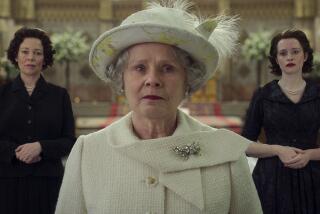Easy lies the head that wears this crown
- Share via
Elizabeth the Queen
The Life of a Modern Monarch
Sally Bedell Smith
Random House: 684 pp., $30
--
Sure, why not. Let’s have yet another biography of Elizabeth II, this one as she’s about to mark 60 years on the throne.
So what is new to justify Sally Bedell Smith’s massive “Elizabeth the Queen”? What is left to uncover, and what should be left uncovered and unknown in the life of this exemplary lady whose predetermined existence of regal obligation is yawningly unenviable, however bejeweled the box it comes in?
Smith’s book answers those questions with a double yes -- yes, there are mercifully things that cannot be known about Elizabeth II, however hard the world tries (there is an index entry for Elizabeth II, perspiration, lack of.) And yes, there are things to be learned about Elizabeth II as she changes and the monarchy changes with her.
Sometimes it’s trivial; an American acquaintance says the queen collects pepper grinders. And sometimes it’s about the queen’s own words on her ancient calling in the 21st century. With characteristic briskness, she told her cousin Margaret Rhodes that her sanctified role means no retirement until death, “unless I get Alzheimer’s or have a stroke.”
Here is where Smith breaks new ground, in the nature of the cooperation she got. She interviewed by her reckoning more than 200 people, 40 of whom wished to be anonymous. That’s usually a red flag, but in Smith’s case, the other 160 include the queen’s relatives and friends. That suggests that some of the nameless 40 may be even closer to the action.
Taken in sum, along with the assistance the author got from what she calls the “staff at Buckingham Palace” (Smith must mean high-ranking figures in the royal household; in palace speak, the staff are the servants, a word the queen dislikes), it suggests that the “ring of silence” around the queen, as one chapter describes it, is thinking “legacy” on behalf of a queen who is symbolically regal but personally modest, a woman concerned about the image of her thousand-year-old inheritance but who refuses to so much as pluck her eyebrows.
Smith acknowledges the pitfalls of an American writing about a singularly British institution. The monarch’s role is a complex one: head of state but not head of government, reigning but not ruling. But perhaps because of that, Smith is at pains to do a vivid job of making the queen’s relationship with prime ministers and the Commonwealth more comprehensible. As one example, during Britain’s economic turmoil of 1973, the queen wanted to end her Christmas speech with a bland “few sentences” of concern. Prime Minister Edward Health told her she could not. She watered down the remarks even further, and again the prime minister said no. So constitutionally, she could say nothing.
Biographies such as this also depend on already published material. The queen is 85, after all, and writers have been mining her life, her family and her kingdom for decades. One frustration in Smith’s book is the scantiness of attribution within the chapters themselves. Footnotes are probably a buzz kill for books such as this, but time after time, quotes and information left me wondering, “Where did she get that?” and having to flip back and forth from the text to the notes, like having to look up the answers for a particularly tricky crossword puzzle.
Quoting the loving words between newlyweds William and Kate, riding in the state landau right after their wedding last year, had me wondering where that came from. Back to the notes, which credited the Mail on Sunday newspaper, which must have employed a lip-reader -- unless one of the postilions on the coach was a plant, as happened when another tabloid newspaper secretly got a reporter hired on as a Buckingham Palace footman.
Smith is even-handed about assessing the queen’s parenting skills and her children’s marital turmoil, mostly through the words of confidants such as the former Archbishop of Canterbury and relatives. Over one dinner with cousins, the queen said of the reckless doings of Diana and Sarah, “Can you imagine having two daughters-in-law like this?”
But Smith clearly admires the queen’s stoicism and endurance. The book’s endpaper photos of the queen all show her smiling -- except for four: the funeral of Earl Mountbatten, killed by the IRA; a few moments after a man in a crowd fired six shots at her (blanks, as it turned out); at the decommissioning of the royal yacht Britannia; and at her coronation, in the moments before she was anointed with holy oil, a far more spiritual ceremony for her than the crowning.
In her last chapter, Smith opens up the “whither the monarchy” speculative stakes. The subtitle of the book is “The Life of a Modern Monarch,” and the thread Smith follows is how the monarchy has had to embrace its own Darwinian version of flexibility, never ahead of the times but also trying not to be fatally far behind them.
“A powerful source of the queen’s success as sovereign has been her inscrutability and avoidance of controversy,” something not the case with her son and heir, Charles, whose thoughts are widely known, in part through his own sometimes artlessly open interviews and speeches. The queen’s concerns about the future of her throne are grounded as much in what goes on inside her family as about republicans pounding on the palace gates.
It used to be treason, punishable by death, to contemplate or “compass” the death of the monarch. Now it’s a matter for writers, and an international public contemplating the queen’s diamond jubilee, and the state of the realm thereafter. The celebration is in June -- plenty of time to swot up on your royal knowledge, and Smith’s is a smart and satisfying book to do it with.
--
More to Read
Sign up for our Book Club newsletter
Get the latest news, events and more from the Los Angeles Times Book Club, and help us get L.A. reading and talking.
You may occasionally receive promotional content from the Los Angeles Times.











